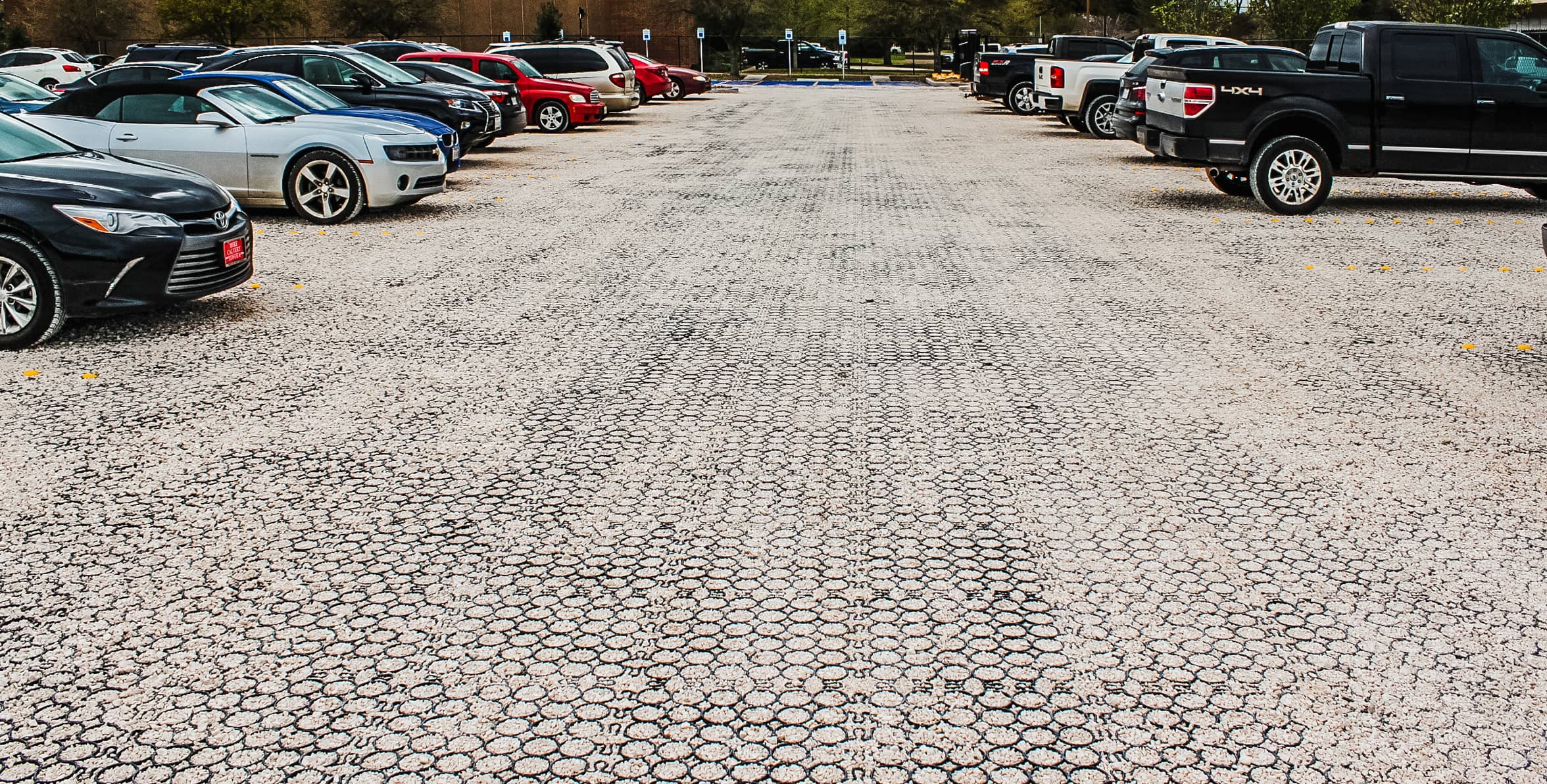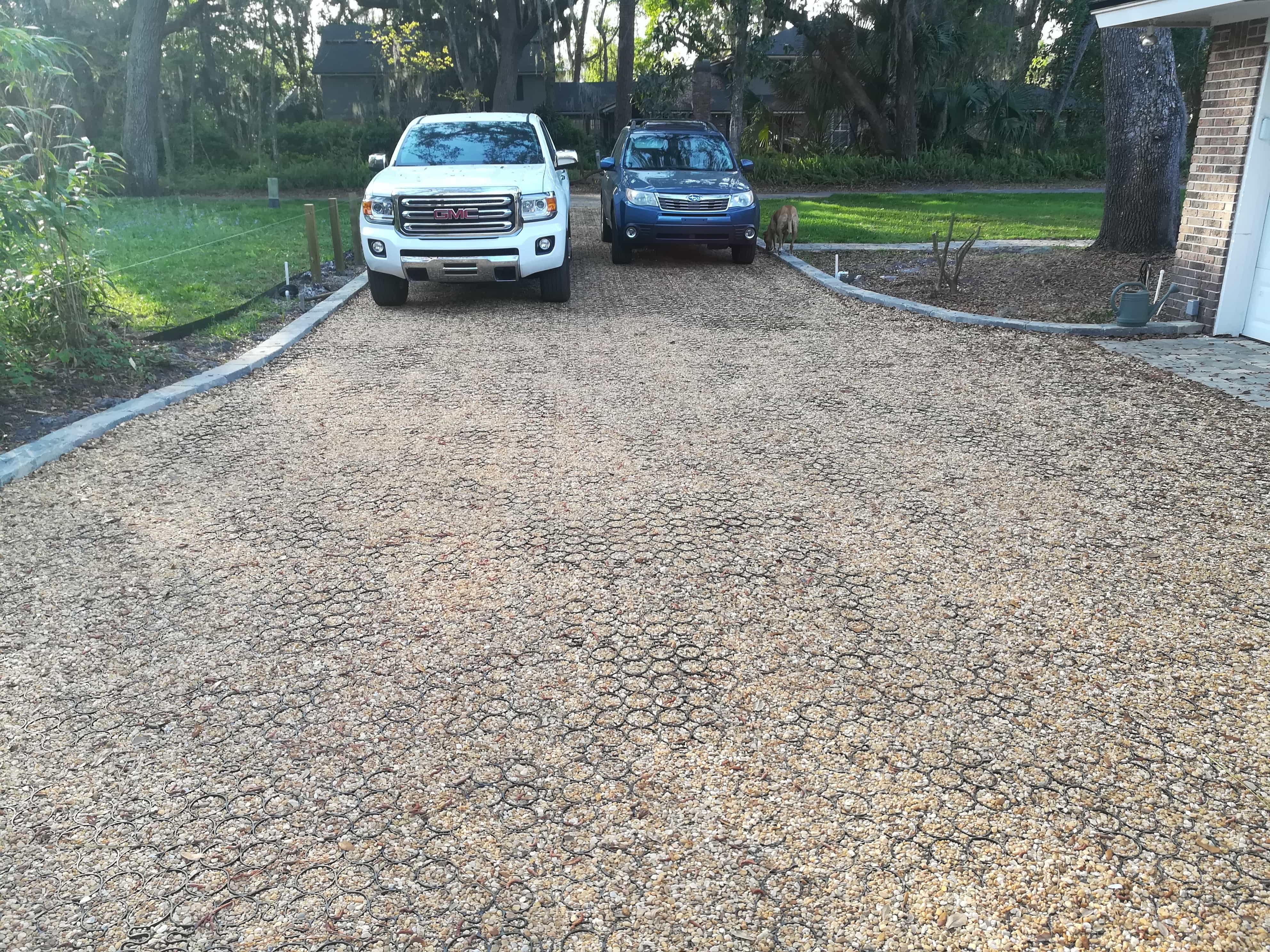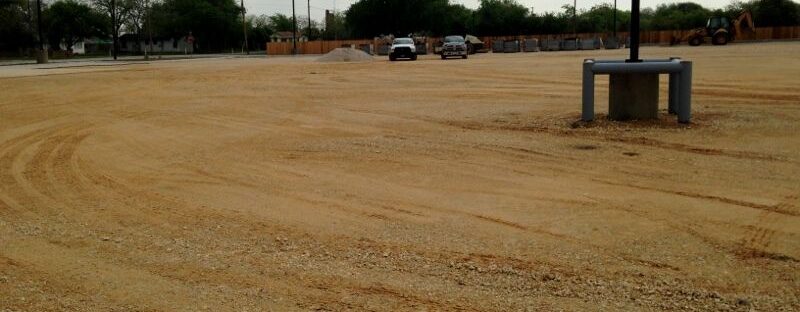
Driveways fail early when the paving material doesn’t match real-world site conditions. Traffic demands, grading, drainage, and long-term durability all affect performance. This guide compares driveway paving options to help you choose a surface that holds up over time.
Gravel, Asphalt, and Concrete: The Most Common Options
Each of these materials behaves differently under real-world use. Here’s how they perform in terms of stability, drainage, and long-term maintenance.
Gravel Is Low-Cost, But High Maintenance
Among the most common driveway paving options, gravel installs quickly with basic tools and drains water directly into the subgrade. Its loose fill is ideal for rural properties or low-traffic lanes. But without solid edge containment, adhesive binders, and a 6–10-inch compacted stone base, gravel driveways quickly rut, shift, or erode—especially on inclines.
Weeds, migration, and frost heave are common maintenance issues. Regular traffic use, water and wind requires the material to be raked back or replenished. Without proper prep and occasional upkeep, gravel offers short-term savings at the cost of long-term stability.
Asphalt Installs Fast But Softens in Heat
Among all driveway paving options, asphalt installs fast and can be ready for traffic within days. Crews pour and compact it in place, forming a smooth, impermeable blacktop. Asphalt absorbs solar heat, which makes it easy to snowplow—but in warm climates, softening and surface bleeding become issues.
Sealing is required every few years to extend life span, especially in freeze-thaw zones where cracks form easily. Expect 15 to 30 years of service with proper sealing and drainage management. Without it, surface degradation can occur within a decade.
Concrete Is Durable But Doesn’t Drain
Poured concrete delivers a strong, low-flex slab that holds its shape under heavy vehicles and sustained use. It’s one of the most durable driveway paving options, especially when installed with controlled joints and a stable subbase. It’s also customizable with scoring or pigmenting.
But concrete is impermeable and prone to cracking in high-moisture or expansive soils. Where elevation changes direct water toward the driveway, runoff builds quickly and may create downstream problems. With professional installation and sealing, concrete driveways can last 25 to 50 years. Typical costs range from $4 to $10 per square foot.
Patching vs. Rebuilding: How Material Choice Affects Repairs

One important consideration with traditional materials is what happens when repairs are needed. Asphalt often requires full resurfacing once cracks and deformation set in. Concrete can’t be patched without visible joints or discoloration.
In contrast, modular systems and permeable surfaces allow for targeted repair without disrupting the entire structure. Although rare, repair can be needed due to vandalism or other external forces, TRUEGRID systems can be topped with fresh gravel or replaced sectionally, reducing long-term repair costs and downtime.
Modular Pavers Add Flexibility and Repairability
Pavers deliver long-term surface performance when installed over a properly prepared base. They allow for material movement without cracking and can be repaired one unit at a time.
Pavers Are Strong, Replaceable, and Built to Flex
Interlocking pavers—brick, stone, or concrete—are engineered to support traffic while adapting to surface movement. They’re often installed with sanded joints and border restraints, which allow seasonal expansion and freeze-thaw behavior without structural failure. Most concrete pavers exceed 8,000 psi compressive strength and can last 50 years or more.
Modularity is the primary advantage. If one paver cracks, you can replace it without tearing up the entire driveway. That makes pavers ideal for homeowners who want a blend of performance and repairability.
Precision and Base Prep Make or Break Performance
To work long term, pavers require compacted subgrade, bedding sand, and consistent leveling. Without proper prep, joints open, pieces shift, or edges sink. Freeze cycles accelerate joint erosion and heaving if the bedding isn’t installed correctly.
Brick and stone pavers cost more—$10 to $30 per square foot—but offer permeability when sand-set. In snow-prone areas, their open joints can reduce frost disruption and help surface water escape.
Permeable Driveway Paver Systems for Drainage and Durability
These systems are designed to reduce surface runoff by draining water through the surface and into a prepared base. They’re often used in locations where impermeable driveways cause downstream flooding, erosion, or compliance issues.
Built to Move Water, Not Shed It
This final group of driveway paving options includes permeable paver systems built for infiltration. These surfaces—typically filled grids or open pavers—allow water to drain vertically through stone-filled cells or joint openings. That water then filters through a compacted open-graded base layer, eliminating surface discharge.
Because the water doesn’t collect or sheet off, permeable systems reduce runoff load on local stormwater infrastructure and help meet retention or infiltration targets. They’re ideal for infill lots, elevation changes, and clay-rich areas where traditional paving fails to drain.
In addition to drainage, permeable systems contribute to groundwater recharge, support urban tree root zones, and filter pollutants such as oil, heavy metals, and road debris before they reach waterways.
Designed to Resist Rutting and Surface Failure
Unlike gravel-only installs, permeable grids lock fill material in place. Recycled plastic panels interlock to prevent movement, and their cell-wall structure spreads load across a wider area. This prevents rutting, potholes, and edge loss even under turning traffic.
These systems don’t require sealing or resurfacing. The fill can be cleaned or topped off without disturbing the grid. That makes them ideal for long-term use with minimal downtime.
Base Layer Matters for Long-Term Drainage
Like all surfaces, permeable driveways require a base layer. Most installs use 100 to 150 mm of clean angular stone beneath the grid to store water temporarily before it filters into subsoil. This base structure handles stormwater volumes and supports loads at the same time.
When installed correctly, permeable systems can outperform concrete and asphalt on challenging properties—especially where rainfall and site geometry complicate traditional paving.
TRUEGRID: Engineered Strength with Built-In Drainage

Permeable paving systems from TRUEGRID combine structural strength with built-in stormwater control—delivering a surface that performs where traditional materials fail.
PRO LITE for Residential, PRO PLUS for Heavy Use
TRUEGRID panels are made from 100% post-consumer recycled HDPE and engineered for long-term driveway performance. The PRO LITE system is optimized for residential use, while PRO PLUS handles heavy-duty vehicle traffic and H-20/HS-20 loading. Each 24″ × 24″ unit interlocks to form a stable surface across varied terrain, including soft subgrades and sloped sites.
Fast Install, Real Jobsite Metrics
Installed over 6 to 10 inches of compacted open-graded stone, the system delivers enough compressive strength for any street legal vehicle, and more. Installers can lay up to 1,000 square feet per man-hour without curing delays. Trucks can drive over empty grids during the fill stage to accelerate the process.
Prep Checklist Before Installation
Materials: TRUEGRID PRO PLUS or PRO LITE panels; clean angular gravel (for fill: ½” to ¾”, depending on model, and base: ¾” to 1.5”, depending on model)
Equipment: Grader or skid-steer, compactor, saw (for edge fitting), rake.
Steps:
- Excavate and level the subgrade
- Proof-roll for compaction
- Install geotextile fabric
- Add and compact base in 4″ lifts
- Start panel placement in one corner, locking grids together via male tabs (cut as needed)
- Install SuperSpot or SnowSpot markers if needed for fire lanes or designated parking
- Infill the grid with angular gravel ( ½” to ¾”, depending on model)
Stormwater Drains Through, Not Off
Instead of shedding water like concrete or asphalt, the surface drains vertically through the gravel fill and into the base stone. This process reduces runoff, filters pollutants like oil and sediment, and recharges groundwater naturally. It’s especially effective in clay-rich soils, flood-prone areas, or sloped driveways where controlling runoff plays a major role.
By eliminating the need for detention ponds in many installations, TRUEGRID can help recover land for usable space—adding value to residential and commercial properties alike.
Customizable, ADA-Compliant Surface Options
TRUEGRID allows multiple gravel types to match the surrounding hardscape or landscape. TRUEGRID has been tested to meet ADA compliance standards. SuperSpot and SnowSpot markers can also be added to designate parking areas, accessible zones, or fire lanes.
Install TRUEGRID Permeable Pavers for Surface Stability and Drainage Control
TRUEGRID pavers eliminate surface cracking, rutting, and runoff by draining water through a compacted base. Our system stays locked in place under vehicle loads and performs on clay, varied terrain, and freeze-thaw sites. Contact us today for more information.



